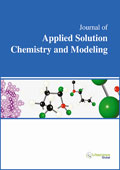jascm
|
|
Abstract: Pyrolysis of Persian Hogweed(Heracleum persicum Desf.) stalks were performed in a fixed-bed tubular reactor with (K2CO3, ZnCl2) and without catalyst at three different temperatures (400, 500 and 600 oC) with a constant heating rate of 50 oC/min. and with a constant sweeping gas (N2) flow rate of 100 cm3/min. The amounts of bio-char, bio-oil and gas produced were calculated and the compositions of the obtained bio-oils were characterized by GC-MS. The effects of pyrolysis parameters such as temperature and catalyst on the product yields were investigated. According to the results, both temperature and catalyst had significant effects on the conversion of Heracleum persicum Desf.into bio-chars, bio-oils and gaseous products. The highest bio-oil yield of 41.42% by weight including aqeous phase was achieved with 10% potassium carbonate catalyst at 500 oC. 71 different compounds were identified by GC-MS in the bio-oils obtained at 500 oC. Keywords: Energy, Biomass, Pyrolysis, Bio-oil, Persian Hogweed, Heracleum persicum Desf.Download Full Article |
|
|
Abstract: Solvation free energies ∆Gsoltot of cyclic polyethers (CH2CH2O)n (n=2,6) in aqueous and tetrachloromethane solutions have been calculated at HF, MP2 and B3LYP/6-311G (d,p) levels of theory using CPCM, IEFPCM and SMD implicit solvation models. It has been found that ∆Gsoltot are negative for both solvents, they increase linearly with system sizes and they are more important in water solution. The electrostatic contributions to the solvation free energies ∆Gsolele are also more important in water because of their polar nature. In water, CPCM and IEFPCM models give a close values, which are slightly different from SMD values. In tetrachloromethane solvent CPCM model seems overestimate ∆Gsolele. For both solvents the non-electrostatic contributions to the solvation free energies ∆Gsoln-ele provided by SMD are remarkably different to those given by CPCM and IEFPCM models Keywords: Continuum model, Solvation free energy, Cyclic polyether, Water, Tetrachloromethane.Download Full Article |
|
|
Abstract: The density data for the binary mixtures of an ionic liquid (IL), 1-ethyl-3-methylimidazolium diethylphosphate [EMIM][DEP], and water (methanol or ethanol) were measured at 1 atm as a function of composition in the temperature range of (293.15 to 333.15) K using a vibrating-tube densimeter. The excess molar volumes (VE) and other thermodynamic properties were derived from the density data. All VE values are negative for the binary mixtures in the whole composition range, and reach to the maximum at the mole fraction of IL of ca. 0.3. The VE values decrease with increasing temperature for the aqueous solution of ILs, but increase with the increasing temperature for the IL solutions of methanol or ethanol. The excess molar volumes were correlated successfully by an empirical equation with the maximum average absolute relative deviation within 0.02%. Keywords: Density, excess volume, ionic liquid, water, methanol, ethanol.Download Full Article |
|
|
Abstract: Phycocyanin, a blue protein extracted from Spirulina spp, shows promising characteristics that made it suitable for its use as natural dye in photovoltaic devices as the dye sensitized solar cells. In this work, a study of the aqueous solution-phase photochemistry, photophysics, spectroscopy, voltammetry and thermal stability of phycocyanin is presented. Suitable redox potentials (Eox = 1.2 V vs. Ag/AgCl) and a value of 1.96 V for E0,0 (i.e., the energy difference between the vibrationally relaxed levels of the first electronic excited state, S1, and the ground state, S0 of phycocyanin), allows the calculation of energetic profiles that in comparison with the conduction band of the anatase-TiO2 and I-/I3- electrolyte, could predict electron transfer with these components of the cell. The data reported herein should not only help to evaluate the potential use of phycocyanin as sensitizer for solar cells, but should also help in the development of novel solar cells where the photoinduced behavior of this protein can be controlled. Keywords: Natural dye, DSSC, energy level diagram, phycocyanin.Download Full Article |
|
|
Abstract: The notion of entropy-enthalpy compensation (EEC) is well known and hotly debated up to now. Nevertheless, any valid EEC phenomenon ought to have in sooth a definite physical-chemical sense. The roots of the latter are discussed here in detail. Keywords: Enthalpy, entropy, compensation, free energy, exergy, availability,thermodynamics.Download Full Article |



